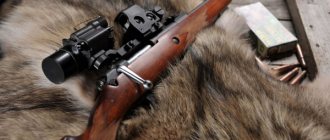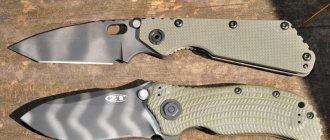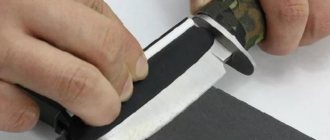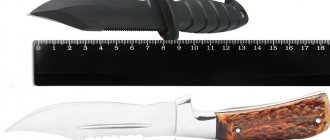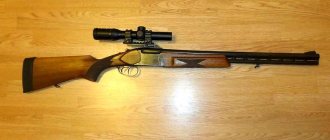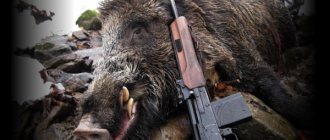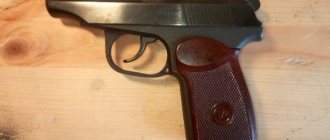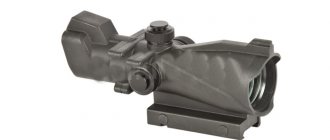Product Features
Knives made during the Soviet period were in high demand. Any model, from folding to combat, was very popular among the population. A striking example is the famous Finnish NKVD. This blade has nothing in common with Finland; it was developed using an original made in Sweden. Another well-known variant is the HP 40, which was so effective that it was used to arm the army during the North Finnish War.
Knives from the times of the USSR were characterized by high quality and reliability. Although modern models are made from materials with improved performance, products that have survived several decades have stood the test of time and retained their unique properties. The base of the blades was made of the following materials:
- carbon steel of various grades;
- stainless steel processed at temperatures up to 500º.
In the USSR, there were special GOST standards that determined the characteristics of blades. For example, for folding structures, steel of the first (52-58) and highest (55-58) categories was used. Factory-produced pocket knives are actively used these days, which confirms their reliability and durability.
One of the most popular Soviet folding knives was called “Belka”. The model was considered a business model, as it was often used for slicing food. Today, an improved product, complemented by a Back Lock lock, is produced by the Brutalica Knives brand.
Blade material
The main quality of a diving knife is its immunity to corrosion. Typically, underwater blades are made of alloy steel, or a protective coating is applied to the blade: epoxy, Teflon or calgard. But the coating is unreliable protection, so after each use in salt water the blade should be washed with tap water and dried.
Rust primarily attacks the cutting edge of the tool, so diving blades quickly lose their performance. Diving blades are also not hardened to extreme hardness, that is, they are relatively fragile.
The most commonly used stainless alloys for production are:
- chrome-nickel series 300 - resistant to rust, but wears out quickly;
- chrome series 400 - susceptible to corrosion, require care after each dive, but do not require sharpening for a long time.
In Russia, steel grades 95×18 and 110×18 are used for the production of diving knives.
Titanium blades with an oxide anti-corrosion coating have good performance. These are lightweight products with an antimagnetic effect. But there are also disadvantages: such products are expensive, they have relatively low hardness. Therefore, mainly titanium alloys are presented on the modern market.
Legendary models
Many knives made in the USSR were known throughout the country. The secret of popularity lay in its high efficiency, practicality, ease of use, or enormous usefulness in battles with the enemy. The success of the models depended on certain positive properties, so they forever left their mark on history and became truly legendary.
Officer
The main feature of the model is its versatility. In addition to the blade, a screwdriver, a corkscrew and other useful household devices were hidden in a steel handle with plastic linings. The first knives included a leather sheath; later they began to be made from wood.
The design was developed in 1945. The knife got its name because the first batch of the product was issued to senior officers. Over time, thanks to its versatility, the blade became widespread not only in the military environment, but also in everyday life. Today similar products are produced by the Swiss brand Victorinox.
Pantry
The knife was used for preparing a variety of cold appetizers, as well as for table setting. The blade was made of high-quality steel, the handle was made of plastic. There were several types of blades:
- General. A knife with a straight blade, the length of which reached 26 cm. It was used for cutting butter and cheese.
- Bread. It was a saw blade with a blade 28 cm long.
- Fruit. Supplemented with a special stainless steel element. Length – 17.5 cm.
- Trancher knife. Used for slicing meat products. The sizes varied between 22-30 cm.
In the Soviet Union, the buffet knife was used in grocery departments, catering establishments, and also in everyday life. Today, many companies produce similar products.
Diving
This knife was intended for use under water, its weight reached almost 1 kg. The model became widespread not only in the USSR, but also in America and Italy. Although this design has a small production volume, it is considered unique. The narrow blade has a bevel called a “pike”; a false blade is located on the butt. The length of the product reaches 334 mm, the size of the cutting surface is 172 mm.
The characteristics of the knife ensure ease of use under water; the handle can be easily grasped with a gloved hand. The metal blade is complemented with a protective coating, and the body has water-repellent properties. The blade is equipped with a brass sheath, which is attached to the belt. The model is produced today, but in an improved form.
The diving knife copes well with various obstacles under water. The blade easily cuts through algae, wire and other objects that interfere with work.
Anti-sabotage
It is one of the modifications of a diving knife, used to fight the enemy underwater and eliminate various obstacles. The blade is capable of cutting ropes, metal wire, and algae. Thanks to a special blade on the butt, the blade cuts iron products with a thickness of no more than 15 mm.
Despite the impressive size and weight typical of knives for use under water, the model is not classified as a bladed weapon. Disadvantages include bulkiness and inconvenience when wearing. Today, the anti-sabotage knife is produced in an improved and lightweight form.
Hunting
A knife equipped with special extractors was used to remove the cartridge case from the gun. Soviet models were relevant for 12 and 16 gauge. In appearance it is similar to a pen blade, the main difference being the so-called “horns”.
A hunting knife was often used for cutting up carcasses, although there is a separate type of blade for this purpose. Today, such models are no longer produced due to loss of relevance and changes in the design of weapons. However, rarity lovers will be able to appreciate this unusual item.
History of creation
In the 60-70s of the twentieth century, more practical hose scuba tanks of the ShAP-40, ShAP-62 and ShAP-77 types were created to perform tasks at shallow and medium depths.
Their use significantly reduced the overall weight of the diver's equipment, due to which oxygen cylinders for emergency situations were included in the basic package, which made it possible to breathe in extreme conditions or in cases where the hose is disconnected while performing a task in a confined space.
By improving equipment, divers were able to perform a wider range of tasks and at the same time reduce the level of danger when performing them.
Considering that the ventilation system had changed, it became necessary to change the sea knife with which all divers were equipped. At the end of 1970, a new model called NVU (universal diving knife) entered service.
Since that time, this weapon began to be included in the basic equipment of submariners of the USSR Navy, as well as underwater special forces. It was used to overcome small underwater obstacles, such as abandoned fishing nets and cables, that is, it cuts through all obstacles that interfere with the work.
Special diving knife.
In addition, with the help of a knife you can eliminate underwater predators, and in wartime, enemy swimmers.
Rare folding knives
Not all blades made in the USSR have survived in large quantities. Many models were produced in limited editions, so they did not hit the shelves. This was due to many factors: the use of complex technologies, high cost, and manual assembly of structures. Today the following products are rare:
- Fishing. The main feature of the knife is the presence of abrasive bars for finishing the hook tip, awl and extractor. This is what ensures maximum human convenience when fishing. The ideal steel grade for blade production was 65G.
- Folding Hunting. The knife with a folding design has a length of 240 mm and can be equipped with a sheath made of pigskin. The hunting product is equipped with brackets for removing cartridges, a screwdriver, a blade for opening cans, and a triangular awl. The blade of this versatile model consists of high-quality carbon steel.
- Sling cutter. The knife is designed to perform only one task - cutting parachute lines when landing on trees or water. A diamond-shaped blade with a double-sided sharpening and a concave edge can well be used as a military weapon. The length of the structure is 23 cm, the blade is 13 cm.
- Davydkovo. The second name is DK-1. It is a small, convenient product with a plastic handle. The model was developed at, which was located on the territory of the village of Davydkovo. Some types of blades were supplemented with an awl and keys. These folding knives from the times of the USSR have survived to this day, but are poorly preserved; many copies have lost their original shape.
- Pavlovo. This is a small product, 20 cm long. The handle is made of plastic. The purpose of the models is to perform gardening and small household work.
- Tourist. A classic pocket knife, indispensable in the wild. The model was produced in several versions with different functionality. The plastic handle usually didn't last long.
- Vorsma. Officer's version with a folding design, complemented by an awl and a corkscrew. The handle is plastic, the total length of the model is 23.5 cm when disassembled. The product got its name from the name of the city of Vorsma, which was famous throughout the country for its unique Vostok and Titan blades.
- Shoe. Folding models with a two-component design, have a plastic handle. Blade length – 197 mm. They got their funny name thanks to the shape of the handle, which looked like a shoe.
- Fox. A rare blade that was produced together with the Panther and Belka models. The length of the blade is 22 cm, the blade is 9.5 cm. The plastic handle makes the design lightweight. The fox is one of the most favorite models of adults and children.
Knives from the USSR are known for their high quality, unique performance properties, and durability. Today they are still popular among ordinary people, and rare versions are among collectors and connoisseurs of rare things. Most of the products can be seen in modern museums.
Fishing
Folding Hunting
Sling cutter
Davydkovo
Pavlovo
Tourist
Vorsma
Shoe
Fox
Safety precautions
A combat knife is a serious weapon that can cause dangerous injuries to a person or even cause fatal consequences. Therefore, when handling such a knife, it is necessary to strictly follow safety rules, including the following recommendations:
- Store bladed weapons in a specially designated place - away from children or bystanders. According to regulations, the scout knife must be stored under a transparent display case with a locking device.
- NO-1 has the parameters of a household knife, which is confirmed in the product passport. But HP models are considered edged weapons, so they should not be carried openly, otherwise law enforcement officers will definitely have questions for the owner of such a knife.
- The blade must not be used other than for its intended purpose. A hunter will not receive permission to carry bladed weapons if he allows their use as a means of self-defense. From a legal point of view, the use of military weapons to resolve conflicts is considered an aggravating factor. Even if none of the participants in the conflict is harmed, the person who threatened with military weapons is subject to criminal liability.
